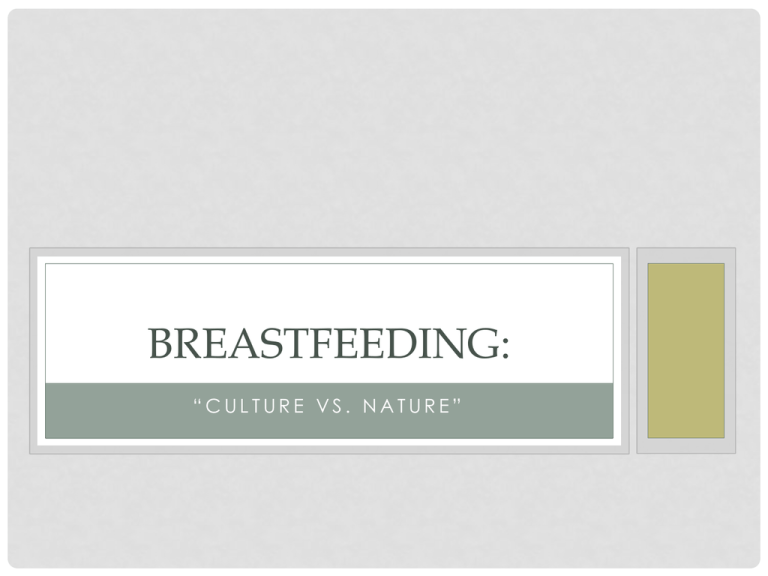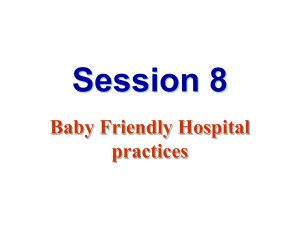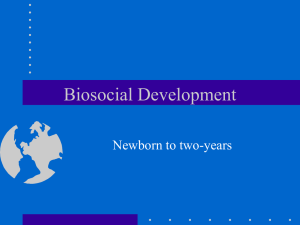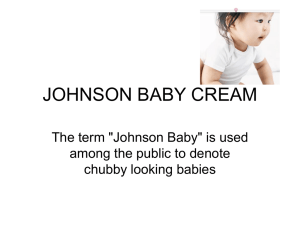Culture versus Nurture - Community Birth Services
advertisement

BREASTFEEDING: “CULTURE VS. NATURE” BIRTH • What happens at birth? • What impact do interventions have on birth/breastfeeding? Syntocinon Induction Epidural Instrumental delivery Caesarian Section AT BIRTH: • • • • • • Vaginal vs. caesarian Separation Baby’s senses Timing / clock watching Hormonal influences Skin-to-skin: When? How? Why? CACHE MAMMALS • Deers • Rabbits • Mature at birth • Hidden for up to 12hrs • 12gms/L protein • High fat FOLLOW MAMMALS • • • • • Mature at birth Follow mother Feed often 4gms/L protein Lower fat content than cache mammals NEST MAMMALS • • • • • • Less mature at birth Nest for warmth Remain with others in litter Feed several times a day 10gms/L protein High fat content in milk CARRY MAMMALS • • • • • Immature at birth Need warmth of mothers body Carried constantly 2gms/L protein & fat Feed constantly “SKIN TO SKIN” CONTACT Humans are mammals! Skin-to-skin contact is a ‘Carrier’ mammal behaviour Mothers chest wall is built for babies! Warmth food and protection When born vaginally the baby is exposed to the mothers pathogens for which she has the antibodies. Babies born by caesarean section are at an increased risk of asthma The release of oxytocin increases the temperature of the maternal chest wall and helps with the bonding process Stabilizes respiration, pulse, blood pressure and temperature INITIATION Breastfeeding is a basic instinct: programmed in the hindbrain Breastmilk immunoglobulin: is mother specific: Formula feeding a baby from birth means the baby is not exposed to the antibodies found in the mother’s milk – some of which have been passed down two generations. Smell and taste of colostrum is unique to each mother Oxytocin found in mother’s milk is a sedative and a relaxant and can assist the baby to recover from the trauma of birth. INITIATION Separation = stress The baby is less stressed in skinto-skin contact – cries less – therefore the blood sugar is more likely to be stable Stress hormones can be identified in a baby separated from its mother – drop by 74% if returned to its mother.6 - not influenced by culture or society. Breastfeeding is an inborn programme in the hind-brain - human babies are born to breastfeed as are all mammals. This baby is a “stoneage baby” in a “space-age world.” Are we nurturing our babies in a ‘mother-led’ or ‘baby-led’ environment? If the babies could choose ………. ? The Breastfeeding Dyad: Mother and baby – belong together. Do not separate mother and baby. SO LETS RECAP………. Anatomy and physiology Culture versus Nature ANATOMY • Shoe size? Hat size? Breast size? – we are all different! • Breast capacity depends on glandular tissue • 4 types of mammals: carry vs follow • Baby knows no different. FACTS • • • • • • 96% of breasts ‘work’ 95% women in New Zealand initiate breastfeeding Breast capacity – variable Feeding frequency – variable Duration Intensity and frequency of feeding If left together the baby and the breast work it out together: Mother-led or baby-led or society-led? Cue-based feeding is the gold standard. IN A BOTTLE-FEEDING CULTURE WE MUST REMEMBER: • Breastmilk is designed for optimal growth • Loss of knowledge of natural breastfeeding makes mothers doubt themselves! • Stop comparing breastfed babies to formula fed infants Growth charts Sleep patterns Feeding frequency • Women must stop comparing themselves with others! An exclusively breastfed baby is the norm. NATURE • Only time in history a woman has had so few babies and breastfed so little! • The female was once either pregnant or breastfeeding during her fertile life (often both) • Hormonally our bodies are now ‘different’ – more likely to be anaemic, (due to menstruation) and increased risk of hormonally controlled cancers. CONCLUSION Culture or nature? • Often mothers want their babies to feed four hourly and to sleep through the night. Breasts and breastmilk invariably do not work this way. • Only 1-4% of breasts fail to produce sufficient breastmilk# – sadly women trying to fit their feeding into the lifestyle of modern culture readily blame their breasts: • “My milk is too thin.” • “I don’t have enough milk.” • Unlimited access to the breast ensures adequate intake in 96% of cases – the breast and baby work it out together. • Interference in this fine balance may compromise the breastfeeding outcome! REFERENCES 1. ‘Computerised Breast Measurement from Conception to Weaning: Clinical Implications’ Creagan MD, Hartmann PE. Journal of Human Lactation 15:89 (1999) 2. ‘Suckling behaviours and growth rates of New Zealand fur seals, Arctocephalus forsteri, at Cape Foulwind, New Zealand’ Chilvers BL, Wilson K-J, Hickling GJ. New Zealand Journal of Zoology; 30 March 2010 3. ‘Delivery by Cesarean Section and Early Childhood Respiratory Symptoms and Disorders The Norwegian Mother and Child Cohort Study’ Magnus MC, Håberg SE, Stigum H, Nafstad P, London SJ, Vangen S, Nystad W. Am J Epidemiol 174 (11): 1275-1285 (2011) 4. ‘Chemosensory Development in the Fetus and Newborn’ Browne JV. Newborn and Infant Nursing Reviews. Vol.8 Number 4 (2008) 5. ‘Early skin to skin contact for mothers and their healthy newborn infants’ (Review) Moore ER, Anderson GC, Bergman N. Cochrane Collaboration (2009) Issue 1 6. ‘Public Health Implications of skin-to-skin contact’ Nils Bergman; powerpoint presentation (2012) 7. ‘Breast Anatomy’ Breastfeeding Answer Book (Update) LLLI March 2012 8. ‘Skin-to-Skin Information’ (pamphlet) NZBA 2010 9. ‘Just a few breastfeeding bits and pieces for your interest!’ Team Hartmann 2005




